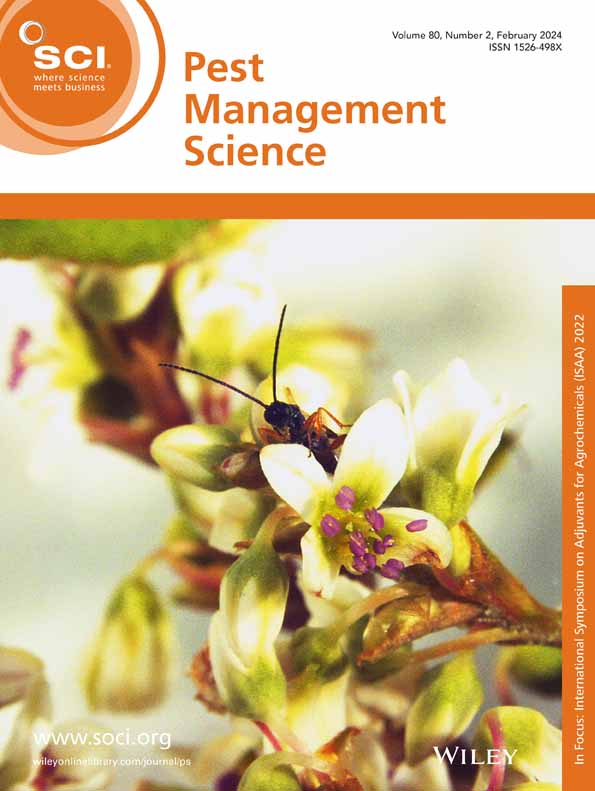对西班牙苋属植物多重抗除草剂群体的分析表明,ecdna来自美洲
IF 3.8
1区 农林科学
Q1 AGRONOMY
引用次数: 0
摘要
抗除草剂入侵杂草苋属(Amaranthus palmeri)威胁着西班牙和其他欧洲国家的农业生产和本土植物生态。除草剂抗性等位基因是就地进化还是通过基因流引入的,目前尚不清楚。为了解决这一问题,我们在两个西班牙棕榈草群体中对乙酰乳酸合成酶(ALS)‐和5烯醇丙酮酰草甘酸- 3磷酸合成酶(EPSPS)‐抑制除草剂具有多重抗性。此外,我们分析了染色体外环状DNA (eccDNA),以确定草甘膦抗性是由局部选择压力引起的还是由基因流引入的。结果两个种群均能在MoA除草剂中存活,对ALS -和EPSPS -抑制除草剂具有多种抗性机制。在抗性植物中发现了8种不同的ALS等位基因突变,包括Pro‐197‐Ile,以前只报道过在一个物种中。两个种群对草甘膦的抗性是由ecdna介导的基因复制的结果。西班牙和北美的eccdna表现出完全的一致性,在部分分析的非编码区序列之间没有发现单核苷酸多态性(snp)。结论在欧洲首次证实了两个西班牙palmeri种群在群体和个体水平上对ALS和EPSPS抑制剂的耐药性。与参考的美洲序列相比,西班牙人群的eccDNA中缺乏snp, ALS基因中存在靶位突变,而没有ALS除草剂的选择压力,这表明抗性性状的起源可能已经在其他地方进化,并从起源地引入西班牙。然而,值得注意的是,研究的种群数量有限,ecdna的部分测序并不能明确证实耐药性机制的确切起源。这项工作引起了人们的关注,即这种和潜在的其他新的抗除草剂棕榈草种群在欧洲的到来,给管理带来了挑战。©2025作者。《病虫害管理科学》由John Wiley &出版;我代表化学工业协会的儿子有限公司。本文章由计算机程序翻译,如有差异,请以英文原文为准。
Analysis of multiple‐herbicide resistant Amaranthus palmeri populations from Spain points to an introduction of the eccDNA from America
BACKGROUNDThe herbicide‐resistant invasive weed species Amaranthus palmeri threatens agricultural production and native plant ecology in Spain, as well as in other European countries. Understanding whether herbicide resistance alleles evolve in situ or are introduced via gene flow remains unclear. To address this, we characterized multiple resistance to acetolactate synthase (ALS)‐‐ and 5‐enolpyruvylshikimate‐3phosphate synthase (EPSPS)‐inhibiting herbicides in two Spanish A. palmeri populations at the plant level. Additionally, we analyzed the extra‐chromosomal circular DNA (eccDNA) to determine whether glyphosate resistance resulted from local selection pressure or was introduced by gene flow.RESULTSBoth populations exhibit individuals that survived both herbicide MoA, with multiple resistance mechanisms to ALS‐ and EPSPS‐inhibiting herbicides. Eight different ALS allele mutations were identified in resistant plants, including Pro‐197‐Ile, reported only in one species previously. Glyphosate resistance in the two populations is to the result of gene duplication mediated by eccDNA. Spanish and North American eccDNAs showed complete identity, with no single nucleotide polymorphisms (SNPs) found between the partial analyzed sequences of noncoding regions.CONCLUSIONWe confirm for the first time in Europe resistance to ALS and EPSPS inhibitors at both the population and individual levels in two Spanish A. palmeri populations. The absence of SNPs in the eccDNA from Spanish populations compared to the reference American sequence and the presence of target‐site mutations in the ALS gene occurred without selective pressure from ALS herbicides, suggests that the origin of resistance traits may have evolved elsewhere and been introduced from the place of origin to Spain. However, it is important to note that the limited number of populations studied and the partial sequencing of eccDNA do not provide definitive confirmation of the exact origins of resistance mechanisms. This work raises concerns about the arrival of this and potentially other new herbicide‐resistant A. palmeri populations in Europe posing challenges for management. © 2025 The Author(s). Pest Management Science published by John Wiley & Sons Ltd on behalf of Society of Chemical Industry.
求助全文
通过发布文献求助,成功后即可免费获取论文全文。
去求助
来源期刊

Pest Management Science
农林科学-昆虫学
CiteScore
7.90
自引率
9.80%
发文量
553
审稿时长
4.8 months
期刊介绍:
Pest Management Science is the international journal of research and development in crop protection and pest control. Since its launch in 1970, the journal has become the premier forum for papers on the discovery, application, and impact on the environment of products and strategies designed for pest management.
Published for SCI by John Wiley & Sons Ltd.
 求助内容:
求助内容: 应助结果提醒方式:
应助结果提醒方式:


